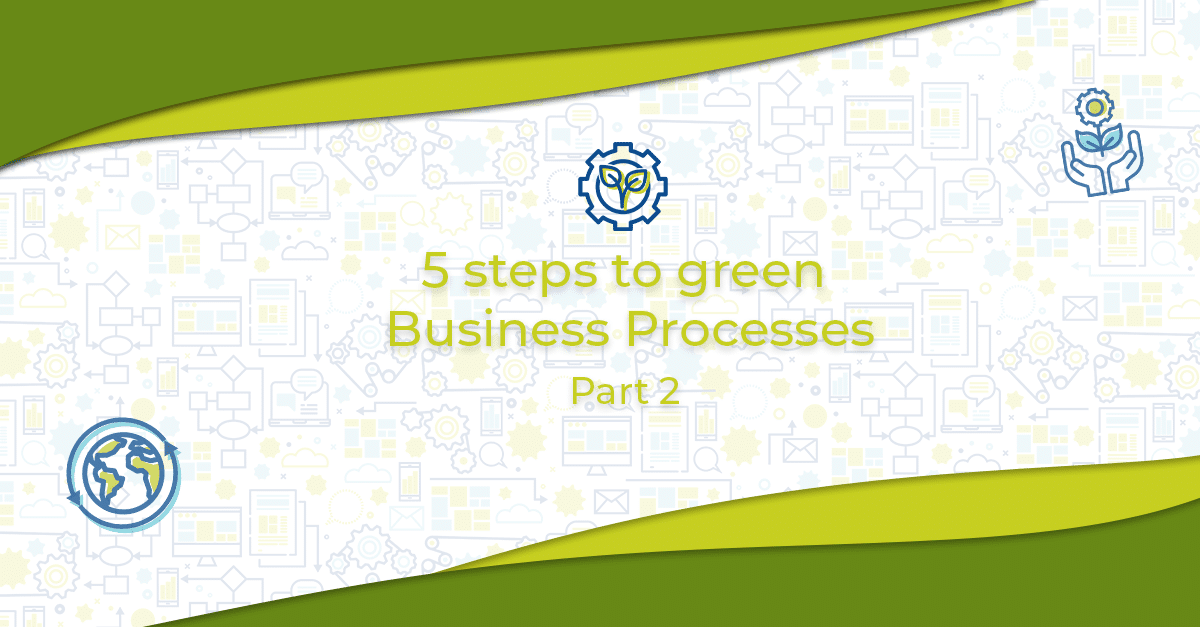5 steps to green Business Processes – Part 2

Rapid climate change is driving companies to become more environmentally friendly. Sustainability already starts in internal processes and must therefore be rethought. In the first part of our blog we already presented you the first two steps. Here are the next 3 steps for greener business processes.
3. Creating transparency – in one central location.
After this preparatory work, it’s time to start collecting data. The challenge: At many companies, the necessary information is located on isolated solutions with “endemic” types of data. In addition, it is often difficult for non-specialists to assess what data actually goes into the carbon footprint. When a package is delivered it is not just about the route, it’s also about the corresponding fuel consumption. In the background, IT systems are also running on servers (including cooling) that enable customers to track their packages. In addition, the human resources managers of the parcel driver may meet to redesign shift schedules…
A Modern Business Process Management Tool
Thus, to obtain robust data on how much carbon dioxide is emitted, responsible parties need to be interviewed to gain relevant data. A modern Business Process Management (BPM) tool helps to reduce this complexity and make information usable in a central system. iGrafx has already stored all questions of the German Sustainability Index (DNK). At the same time, the BPM software offers companies the flexibility they need to develop their individual sustainability standard based on the prioritized sustainability goals, successively link it to the business processes and underpin it with suitable KPIs. Once set up, the sustainability manager can then, for example, start a workflow at the click of a mouse that automatically collects all the required key figures on the CO2 footprint in a specific process and transfers them in consolidated form to a dashboard.
4. Define and implement measures.
If required, you may also need an audit. You have the key data you need to manage your sustainability goals and implement improvements in a verifiable manner. In addition, you can store possible individual measures in the BPM tool – such as the purchase of CO2 certificates or tree planting. For example, a bank defines the goal of reducing its total CO2 emissions by 10 percent in the current year. The sustainability manager will check all relevant processes for savings opportunities and optimize them accordingly together with the individual departments. Here, too, the BPM software provides the necessary assistance and transparency. For what cannot be saved through process improvements, the sustainability manager will make a selection from alternative measures for compensation.
5. Involve employees – live sustainability.
Organizational basis is established through management guidelines, processes and suitable KPIs. It anchors sustainability in the minds of the employees and shows that small but constant improvements can lead to goals. Experienced consulting partners such as Cofinpro accompany companies and show ways in which sustainability management can be continuously developed. An important factor here is the role model function of upper and middle management. Why should an employee take the train if his superior only drives to his business partners in a company car? If sustainability is exemplified by the top management, it sharpens the eye for optimization potential at the grass roots.
The Future
Then, in the future, the suggestions as to where, for example, printouts can be saved. The processes for granting loans will no longer come from the sustainability manager, but from the relevant clerks. A flexible BPM tool can make a targeted contribution to this awareness. This is because it can make the CO2 consumption of a process comprehensible. It also provides supplementary information: Can working hours be adhered to? Are there alternative decisions – for example, can I create an audit-proof electronic document and dispense with the printout?
Anchoring the understanding deeply in the company that sustainability is not a fad. Instead, it’s the general business standard of the future and an investment in the future. Systematic sustainability management needs to be supported by management. This can result in employees wanting to track down sustainability potential, develop ideas and experiment a little. What experiences have you had on the way to more sustainability in your company? What challenges do you face in this context? Contact us to share your suggestions and questions with us.